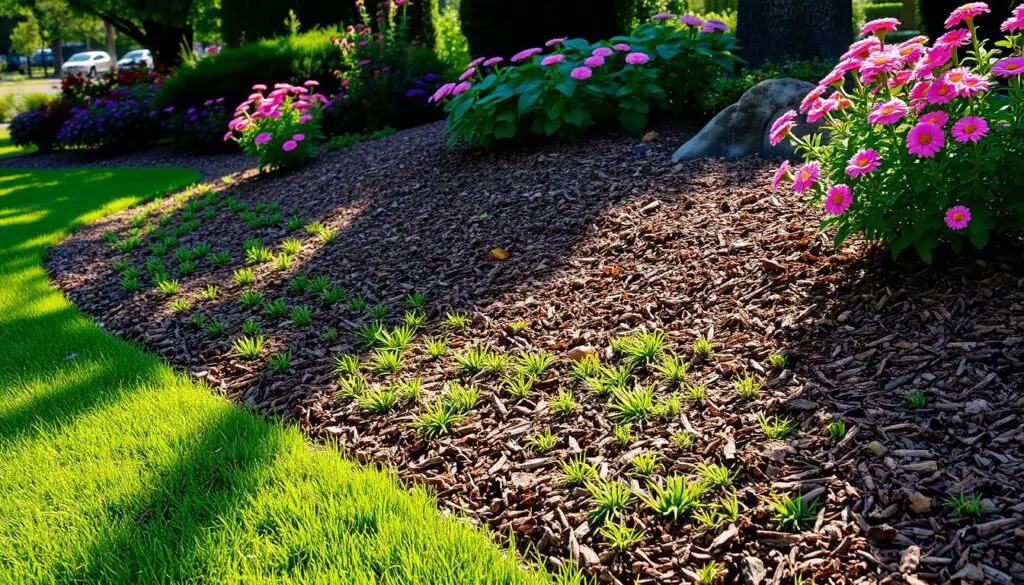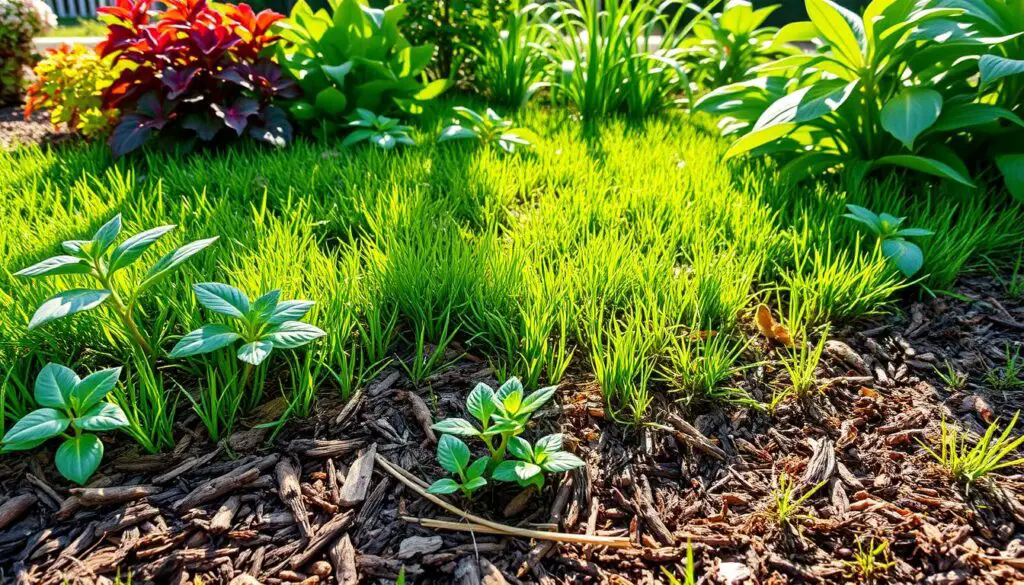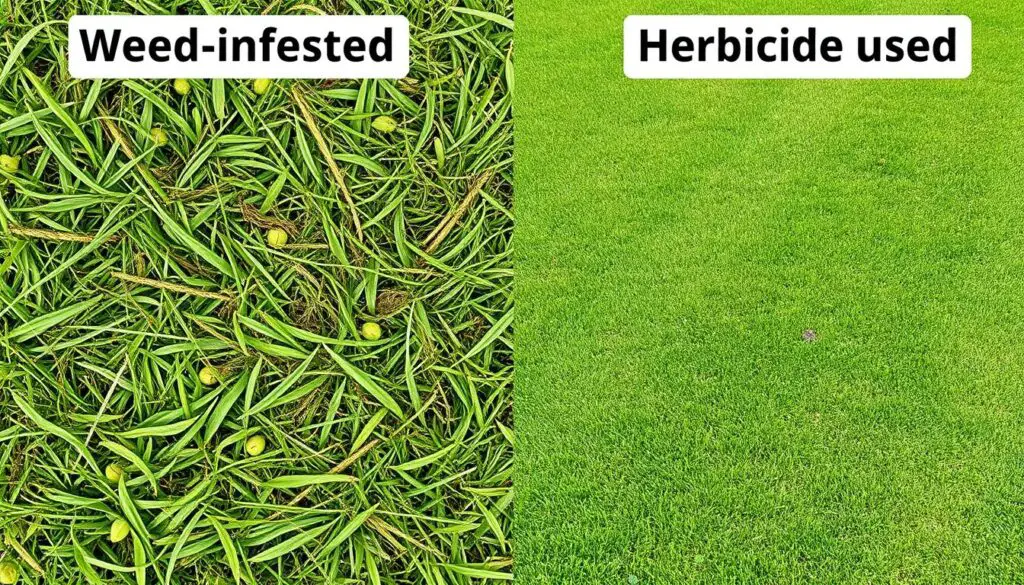Lawn Mulching Benefits And How It Works

Lawn mulching benefits include natural fertilization, moisture retention, weed suppression, and improved soil health, keeping your lawn lush and eco-friendly.
Did you know grass blades are mostly water, with some organic matter and nutrients like nitrogen and potassium? These nutrients are key for a healthy lawn.
The secret to using them fully is lawn mulching. By putting grass clippings back into the soil, your lawn gets a big boost. It grows lush, thick, and vibrant.
Lawn mower mulching, or “grasscycling”, is a simple way to recycle lawn nutrients. When you mow, the mower turns clippings into fine particles that fall back onto the lawn. These particles feed the soil’s microorganisms. They break down the clippings, releasing nutrients that your lawn needs to thrive.
Key Takeaways
- Mulching grass clippings returns valuable nutrients like nitrogen, potassium, and phosphorus to the soil, feeding your lawn.
- Mulching helps retain moisture, suppress weed growth, and reduce landfill waste.
- Regular mulching can lead to significant improvements in your lawn’s overall health and appearance.
- Mulching mowers provide the equivalent of one free fertilizer treatment annually by returning nutrients to the soil.
- Mulching contributes to soil health by increasing microbial activity and providing a food source for earthworms and microorganisms.
What is Grass Mulching?
Grass mulching, or grasscycling, means leaving your lawn’s clippings on the ground after mowing. It’s a simple way to help your lawn and the environment.
The Science Behind Mulching Grass Clippings
Grass clippings are full of nutrient-rich compounds like nitrogen, potassium, and phosphorus. As they break down, they give these nutrients back to the soil. This natural process helps your lawn grow strong and healthy.
The tiny creatures in the soil, like bacteria and fungi, turn the clippings into a nutrient-rich humus. This humus helps keep the soil moisture-rich and aerated. It supports a vibrant and healthy lawn.
Turning Grass into Nutrient-Rich Mulch
Using special mulching blades and a mower deck baffle system can chop grass clippings into tiny pieces. This makes them break down fast and efficiently. The quick decomposition means nutrients get back to the soil quickly. This helps your lawn grow strong and keeps the soil healthy.
Grass mulching turns your lawn’s clippings into a nutrient-rich mulch. It helps control weeds, keeps the soil moist, and supports beneficial microorganisms. This eco-friendly lawn care method saves time and money while being good for the environment.
Mulch is Grass Feed
Lawn mulching benefits include naturally fertilizing your grass without extra cost.
Mulching your lawn is more than just a way to handle grass clippings. It’s a green way to feed your grass naturally. Grass has nutrients like nitrogen, potassium, and phosphorus. When you mulch, these nutrients go back into the soil, helping your lawn grow strong and green.
Mowing your lawn with a mulching mower shreds the grass clippings finely. These small pieces then break down, adding nutrients to the soil. Soil microorganisms turn the mulch into nutrients that your grass can use to grow.
“Mulching your lawn is like giving it a steady diet of natural, nutrient-rich grass feed – it’s a sustainable landscaping practice that keeps your grass healthy and green without the need for expensive, synthetic fertilizers.”
Using nutrient recycling through mulching helps your lawn avoid chemical fertilizers. It’s a green, cost-effective way to keep your lawn looking great all year.
Grass clippings left on the lawn act as a protective mulch, preventing weeds from sprouting.
Mulching Promotes Soil Creation
Microorganisms break down grass mulch into humus. This dark, organic substance is key to healthy soil. It holds water and nutrients like calcium and phosphorus, feeding plant roots.
This process of soil aeration and organic matter buildup boosts soil health. It makes the soil fertile and ready for plants.
A 3-4 inch layer of mulch can stop weeds and weed seeds. It also brings earthworms, whose waste is natural fertilizer. Mulch keeps soil temperature right, cooling roots in summer and warming them in winter.
| Benefit | Impact |
|---|---|
| Moisture Retention | Mulch keeps water in, helping plants and gardens stay moist. This means you might water less often. |
| Nutrient Release | As organic mulches break down, they give plants nitrogen and other nutrients. This keeps the soil nourished. |
| Erosion Prevention | Mulch stops soil erosion from water, wind, or rain. It keeps the soil in place and prevents compaction. |
Mulching creates humus, improving soil aeration and organic matter levels. It’s a great way to make your lawn and garden healthier and more productive over time.

“Organic mulches improve soil structure, enhance nutrient content, and promote beneficial microbial activity over time.” – Richard, ecology expert
Mulching Helps Retain Moisture
Mulching your lawn is great for keeping the soil moist. The mulch layer protects the soil from the sun’s heat. This slows down moisture loss, keeping the soil hydrated longer.
The Mulch Layer Acts as a Sun Shield
Mulching your lawn can help it retain moisture, reducing the need for frequent watering.
As mulch breaks down, it creates a barrier that controls soil temperature. This “sun shield” is key in hot, dry summers. It helps your lawn stay watered, saving you time and effort.
Research shows mulched soil can hold up to 70% more water than bare soil. This is good for lawns and young trees, which need steady moisture to grow well.
| Mulch Benefit | Statistic |
|---|---|
| Moisture Retention | Mulch can retain up to 70% more water in the soil compared to unmulched soil. |
| Soil Temperature Regulation | Mulch acts as an insulator, regulating soil temperature to keep plant roots cool in summer and warm in winter. |
| Weed Suppression | A 2 to 3-inch layer of mulch is effective in preventing weed growth by blocking sunlight and creating a barrier for weed seeds to sprout. |
| Soil Improvement | As organic mulches decompose, they add valuable organic matter back into the soil, improving soil quality and structure. |
Using mulch helps your lawn stay lush and green with less watering. It also boosts your outdoor space’s health and beauty.
Lawn Mulching Benefits
Keeping your lawn green doesn’t have to be hard. Lawn mulching is a simple trick that can make a big difference. It saves you time and money and makes your yard healthier and more eco-friendly.
Grass is mostly water, with nutrients and organic matter in the rest. Mulching grass clippings back into your lawn acts as a natural fertilizer.
This grasscycling method keeps the soil moist, fights weeds, and boosts your lawn’s health. It also cuts down on the need for expensive chemical fertilizers.
Mulching is easier than raking and bagging clippings. With tools like the John Deere MulchControl Kit or STIHL battery mowers, it’s a snap. Plus, it reduces green waste in landfills, making it good for the environment.
But, there are times when you might need to bag clippings. For example, when the grass is too long, leaves are everywhere, or you see disease signs. Still, mulching is usually the best choice for a greener, more sustainable lawn.
| Benefits of Lawn Mulching | Eco-Friendly Advantages |
|---|---|
|
|
Want a better lawn? Try lawn mulching. It’s a smart, eco-friendly way to make your yard lush and green.

Money-Saving Benefits of Mulching
Mulching your lawn can save you money in many ways. It lets you reuse grass clippings, cutting down on the need for expensive water and fertilizer. The mulch from these clippings feeds your lawn, making it look lush and green without costing much.
It also saves you time. You don’t have to rake or clean up after mowing. Just leave the clippings to break down and enrich your soil. This means no more trips to the dump, saving you time and money.
Studies show mulching can give your lawn up to 1/4 of the nitrogen it needs each year. Plus, a mulching blade for your mower is much cheaper than a grass bag. These time-saving and money-saving perks make mulching a wise choice for any homeowner.
“Mulching provides up to 1 pound of nitrogen to your yard in a year, saving you the cost of fertilizer.” – Sam, author of the Mower’s Guide
Mulching lets you have a beautiful lawn while saving money. It’s a simple way to keep your lawn healthy and your wallet happy.
Environmental Benefits of Mulching
Mulching your lawn does more than keep it looking good. It also helps the environment a lot. By using grass clippings as mulch, you cut down on yard waste going to landfills. This makes lawn care more eco-friendly.
Yard waste is a big problem, making up about 13% of landfill waste, says the U.S. Environmental Protection Agency. Mulching helps reduce this waste. It’s a small step that makes a big difference.
Reducing Landfill Waste
Mulching is a simple way to lessen your impact on the environment. It keeps grass clippings from going to landfills. This saves space and reduces waste, making your lawn care greener.
Mulching also improves soil health and saves water and chemicals. It’s good for the planet and your lawn. So, mulching is a smart choice for those who care about the environment.

“Recycling clippings by mulching and leaving on the lawn to decompose decreases the amount of carbon released into the atmosphere by 11 to 59 percent over removing clippings.” – Sam, lawn specialist
When Not to Mulch
Mulching can make your lawn look amazing, turning it into a lush, green space. But, there are times when it’s not the best choice. If weeds are taking over, mulching can make things worse by spreading weed seeds. It’s smarter to bag the clippings and remove them to stop weeds.
Also, mulching might not work if your lawn has been treated with chemicals. These can harm the tiny organisms that break down mulch, leading to thatch buildup. In these cases, it’s wise to bag the clippings until your lawn recovers.
- Avoid mulching if your lawn is infested with weeds, as it can spread weed seeds.
- Mulching may not be effective on lawns that have been recently treated with pesticides or fertilizers, as the chemicals can kill off the decomposing microorganisms.
Mulching is great for your lawn, but you need to know when to use it. By understanding when to mulch and when to bag, you can keep your lawn healthy and weed-free.
| Scenario | Recommended Action |
|---|---|
| Weed-infested lawn | Bag and remove clippings |
| Recent pesticide or fertilizer application | Bag and remove clippings |

Being aware of these situations helps you get the most out of mulching. This way, your lawn stays healthy and weed-free. Remember, a great lawn comes from good lawn care, including knowing when to mulch and when to bag.
Best Practices for Mulching Grass
For the best results, timing and grass length matter a lot. I mulch in the afternoon when the grass is dry. This makes the clippings decompose better. But, avoid mulching in spring when grass grows fast. The mulch might not break down quickly enough.
Timing and Grass Length Considerations
Keeping grass at least 3 inches long is key for mulching. This ensures the clippings decompose and feed the soil well. Also, watch the grass length to avoid it getting too long before mowing.
Maintaining Your Mower Deck
Keeping your mower in good shape is crucial for mulching. Make sure the mower deck is clean and the blades are sharp. This way, the mower cuts the grass well, leaving small clippings that nourish the lawn. By following these tips, you can make your lawn lush and healthy.
To find the best mower for your lawn, check out our reviews on lawn mowers. We have detailed reviews and advice to help you choose.

